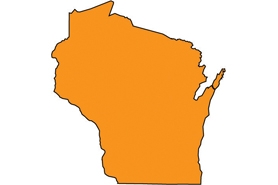Wild parsnip
(Pastinaca sativa)
Herbaceous, monocarpic perennial. Grows as a rosette with upright leaves, persisting for at least one year. Flowering stems are stout, hollow, grooved and up to 5’ tall.
Other names for this plant include:
- Common names: parsnip
- Scientific names: P. sativa var. pratensis
Classification in Wisconsin: Restricted
- Ecological Threat
-
- Invades prairies, oak savannas and fens, roadsides, old fields, and pastures.
- Broad habitat tolerance; grows in dry, mesic, or wet habitats, but it does not grow in shaded areas.
CAUTION: When sap contacts skin in sunlight, it can cause severe rashes, blisters, and skin discoloration (phytophotodermatitis). Wear gloves, long sleeves and long pants when handling. - Identification
-
Leaves: Rosette leaves are pinnately compound with 5-15 broad, ovate to oblong leaflets. Stem leaves are alternate, with 2-5 pairs of opposite, sharply toothed leaflets. Petioles wrap around the stem. Upper stem leaves are reduced to narrow bracts.
Flowers: Numerous small, 5-petaled, yellow flowers in umbels 2-6” wide at the tops of stems and branches. Blooms from late spring to mid-summer.
Fruits & seeds: Seeds are flat, round, yellowish and slightly ribbed. Seeds remain viable in the soil for four years.
Roots: Long, thick taproot.
Similar species: Wild parsnip can be confused with two native prairie species -- Golden Alexander (Zizia aurea) and prairie parsley (Polytaenia nuttallii). Golden Alexander is shorter and its leaves have only 3-7 leaflets. Prairie parsley leaves have few teeth and its flowers are rounded, not flat like wild parsnip.
- Control
-
Mechanical: Cut the root at an angle 1-2” below the soil surface. A brush-cutter can also be used for large populations before seeds are set. Remove flowering heads and dispose of them in a landfill or by burning them.
Chemical: Spot-treat rosettes with 2, 4-D, metsulfuron-methyl or glyphosate. Spot treat adult plants from mid-May to mid-June with metsulfuron-methyl plus a surfactant.
For more information on control techniques, visit the Wild parsnip factsheet [exit DNR] by the University of Wisconsin-Extension.
- Resources
- Sources for content:
- Czarapata, Elizabeth; Invasive Plants of the Upper Midwest: an illustrated guide to their identification and control. The University of Wisconsin Press. 2005. Pg. 70-72


